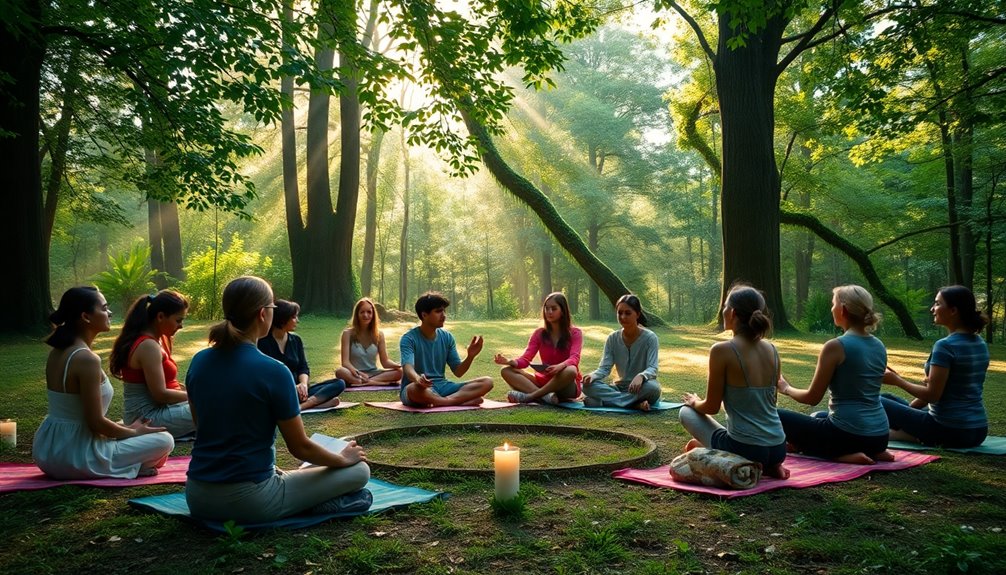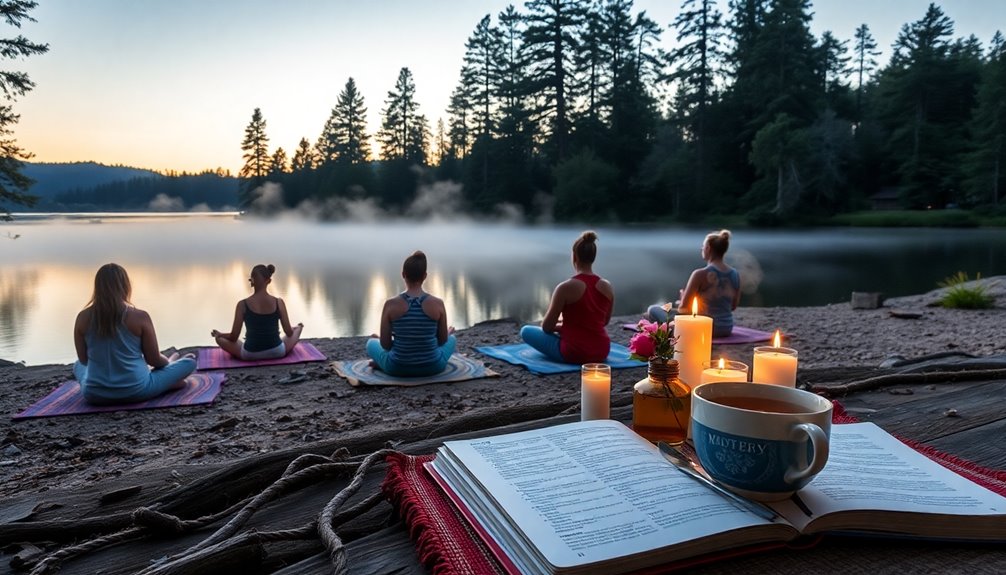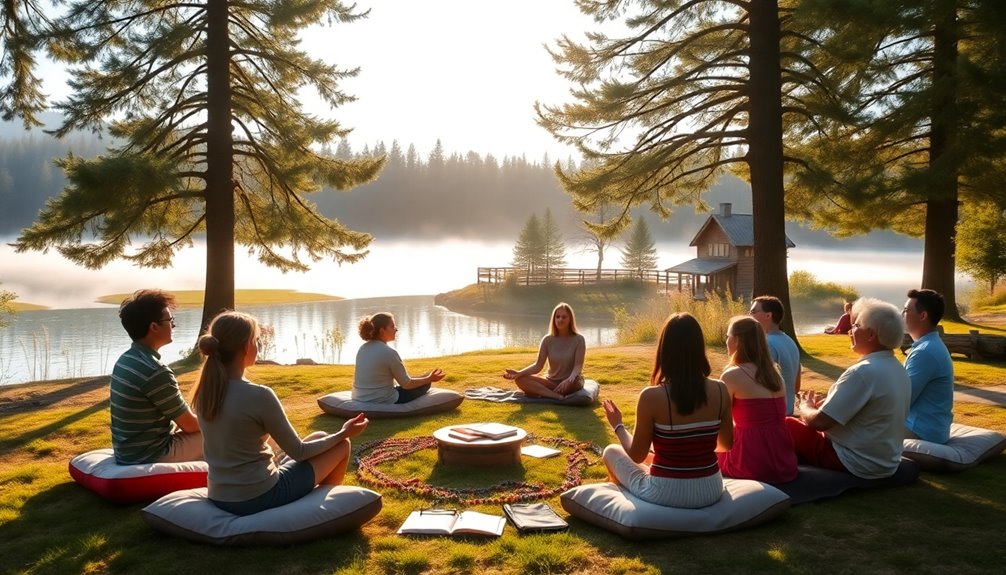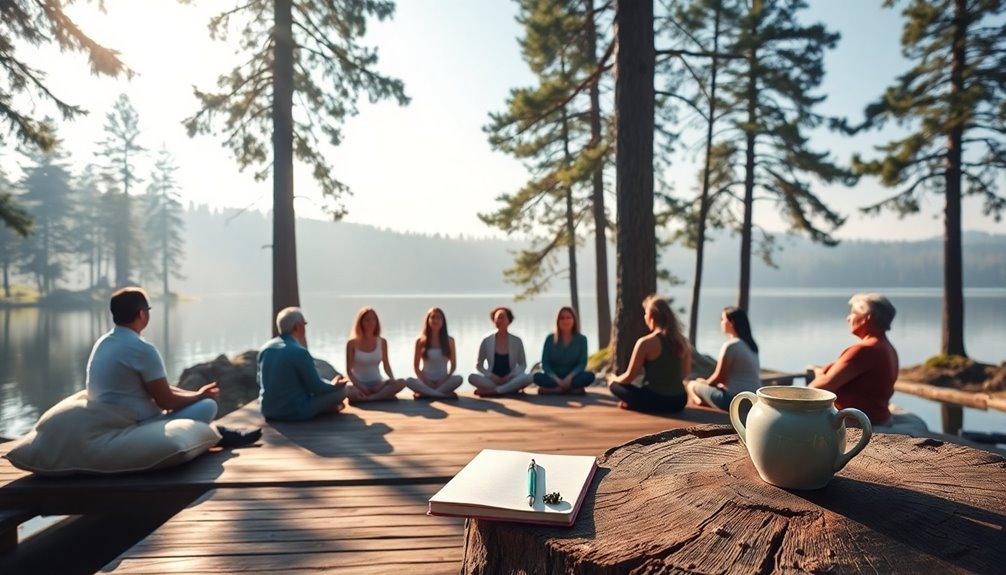For a rejuvenating prayer retreat, start by choosing a serene location that allows you to disconnect from distractions. Engage in guided meditation sessions and reflective journaling to enhance your spiritual clarity. Incorporate activities like silent nature walks and intercessory prayer circles to deepen your connection with God and your group. Create a calming atmosphere using soft lighting and soothing sounds. Remember to set a guiding question for your reflections to keep your focus. This combination of activities will foster spiritual renewal, and there's so much more to explore for your retreat experience.
Key Takeaways
- Incorporate silent meditation walks to connect with nature and enhance mindfulness during the retreat.
- Create guided prayer stations to facilitate personal reflection and deeper engagement with spiritual themes.
- Encourage creative expression through art supplies for participants to visualize their prayers and spiritual insights.
- Organize intercessory prayer circles to foster community and collective support among participants.
- Set aside time for journaling to document insights and feelings, promoting deeper reflection and understanding.
Benefits of a Prayer Retreat

When you take time for a prayer retreat, you disconnect from daily distractions and create space for spiritual growth.
These retreats allow you to focus deeply on your connection with God, enhancing your spiritual journey. As you engage in prayer and reflection, you often find improved mental clarity and emotional healing, promoting mindfulness and self-awareness.
This supportive community environment fosters shared experiences that can deepen your spirituality. Research shows that participants frequently report reduced anxiety and increased well-being after their retreat.
By committing to regular spiritual retreats, you rejuvenate your soul, addressing unmet needs and unfulfilled longings.
Ultimately, prayer retreats not only enhance your connection with God but also cultivate ongoing personal and spiritual growth.
Preparing for Your Retreat

As you prepare for your prayer retreat, choosing a quiet location is essential for creating a peaceful environment that fosters spiritual focus.
To make the most of your time, consider these key steps:
- Pack Light: Limit your essentials to a Bible, journal, pen, water, and a light snack to keep your mind clear.
- Set a Guiding Question: Formulate a question like "What do I need right now?" to help direct your reflections.
- Create a Loose Schedule: Establish a flexible itinerary that includes time for journaling, reading scripture, and meditation.
- Allow for Silence: Plan open periods to listen for God's guidance, ensuring you spend time truly connecting with Him.
Choosing the Right Location

When choosing the right location for your prayer retreat, consider places that offer natural serenity, like parks or tranquil retreats.
You'll also want to think about accessibility and amenities to guarantee everyone can enjoy the experience without hassle.
A well-chosen spot can make all the difference in fostering a meaningful connection during your time away.
Natural Serenity Considerations
Choosing the right location for your prayer retreat can greatly enhance your spiritual experience, so it's essential to prioritize serene environments.
By selecting a spot that fosters natural serenity, you'll connect more deeply with God's presence during your spiritual journey. Here are some key considerations:
- Nature Reserves: Look for areas rich in trees and wildlife, perfect for quiet reflection.
- Water Bodies: Consider locations near lakes or rivers, which can promote tranquility.
- Quiet Retreat Centers: Seek places designed for solitude, away from daily distractions.
- Open Fields: Find spaces that allow for peaceful walks and meditation under the sky.
These elements will help you create an environment conducive to prayer, meditation, and a deeper connection with your faith.
Accessibility and Amenities
Finding the right location for your prayer retreat goes beyond just natural beauty; it also involves considering accessibility and amenities.
Choose a retreat center that's easy to reach by carpooling or public transit, ensuring everyone can participate. Look for venues with essential amenities like comfortable seating, clean restrooms, and quiet spaces for reflection—these elements enhance the spiritual experience.
Natural surroundings, such as parks or nature reserves, provide a peaceful atmosphere for connection with God. Additionally, confirm that the venue accommodates specific needs, like wheelchair accessibility and dietary restrictions.
Consider centers that offer resources like guided prayer stations and group meeting areas, enriching the retreat with opportunities for creative expression and deeper engagement.
Creating the Ideal Atmosphere

To create the ideal atmosphere for a prayer retreat, select a serene environment—like a nature reserve or quiet retreat center—where distractions fade away, allowing for deeper spiritual focus.
Here are four key elements to contemplate:
- Calming Elements: Use soft lighting, candles, and nature sounds for creating a peaceful ambiance.
- Comfortable Seating: Arrange cozy seating to facilitate long periods of reflection and time in prayer.
- Personal Items: Encourage participants to bring personal items like journals, Bibles, and art supplies to express their thoughts and feelings.
- Balanced Schedule: Prepare a schedule that includes both structured activities and ample free time, promoting engagement and solitude for spiritual renewal.
This atmosphere fosters connection with God and enhances the retreat experience.
Engaging Prayer Activities

As you commence your prayer retreat, consider incorporating engaging prayer activities that deepen your spiritual experience.
Silent meditation walks allow you to connect with God through nature, fostering mindfulness and reflection.
Guided prayer stations provide structured opportunities for personal engagement with themes like gratitude and healing.
You might also explore the creative expression of prayer, using drawing or painting to communicate your feelings to God, enhancing your relationship with Him.
Intercessory prayer circles focus on collective prayer for others, building community and compassion.
Finally, communal prayer and sharing encourage vulnerability, creating a supportive environment where you can pray for one another and experience God's presence together.
These activities enrich your spiritual journey and strengthen your connection with God.
Reflection Practices

During your prayer retreat, incorporating mindful meditation techniques can deepen your connection with God and enhance your self-awareness. Journaling for spiritual growth provides a structured way to process your thoughts and emotions, allowing for clearer insights. Together, these practices create a powerful environment for personal reflection and transformation. Additionally, utilizing deep breathing exercises can further promote relaxation and focus during your reflective moments.
Mindful Meditation Techniques
- Breath Awareness: Focus on your breath to anchor yourself in the present moment.
- Body Scan: Relax by noticing and releasing tension throughout your body.
- Mindful Walking: Connect with nature, grounding yourself while fostering peace.
- Gratitude Meditation: Reflect on your blessings to enhance positivity and spiritual well-being.
Incorporating these techniques can deepen your emotional processing, providing spiritual insights that enrich your prayer retreat. Additionally, engaging in mindfulness practices can improve overall mental health and emotional regulation.
Embrace these mindful practices to nurture your spirit and draw closer to God's love.
Journaling for Spiritual Growth
Mindful meditation techniques can open the door to deeper self-awareness, making journaling a powerful tool for spiritual growth during your prayer retreat. By articulating your thoughts and feelings, you gain clarity on your spiritual journey. Incorporate techniques like gratitude lists or personal prayer entries to foster a connection with God's Word. Here's a simple table to guide your journaling practice:
| Prompt Type | Description |
|---|---|
| Gratitude List | Write down things you're thankful for. |
| Scripture Reflection | Reflect on a specific Bible passage. |
| Personal Struggles | Journal about challenges you face. |
| Prayer Entries | Record your prayers and intentions. |
| Community Sharing | Share insights with a supportive group. |
Reviewing your entries post-retreat can also help track your spiritual progress.
Post-Retreat Integration

Integrating the insights gained from a prayer retreat is essential for sustaining spiritual growth. To enhance your post-retreat integration, consider these steps:
- Review your notes: Reflect on key insights and identify actionable steps aligned with God's Word.
- Create an action plan: Outline specific goals based on your revelations to implement your learnings in daily life.
- Schedule follow-ups: Connect regularly with a trusted friend or spiritual mentor for accountability and encouragement.
- Incorporate practices: Establish routines that include daily silence and meditation to nurture lasting spiritual renewal.
Maintaining Spiritual Growth

To maintain spiritual growth after a prayer retreat, regularly reviewing and reflecting on the insights you've gained is essential.
Set aside extended time for personal meditation and prayer, integrating the practices you've learned into your daily routine. This deeper connection with God will help solidify your personal spiritual journey.
Establish an action plan based on your revelations, setting specific spiritual goals to pursue. Engage with a trusted friend or spiritual mentor to share your retreat experiences, fostering accountability and encouragement.
Additionally, participate in local or online spiritual communities to sustain your engagement. These connections provide shared experiences and learning opportunities, ensuring that your spiritual growth continues well beyond the retreat setting.
Frequently Asked Questions
What Should Be Included in a Spiritual Retreat?
When planning a spiritual retreat, you should include time for silent meditation and personal reflection to deepen your connection with God.
Incorporating prayer journaling will help you express your thoughts and insights. Engage in group discussions to enhance understanding of scripture, and explore guided prayer stations focused on themes like gratitude.
Finally, consider creative expressions through art or music to enrich your emotional engagement and foster a supportive community atmosphere.
What to Do on a Prayer Retreat?
Imagine stepping into a serene oasis where your soul can breathe.
On your prayer retreat, start with an opening prayer to invite divine focus. Immerse yourself in silent meditation or a calming walk, letting nature whisper to your spirit.
Grab a journal and pour your thoughts onto the page, nurturing self-reflection.
Join a Scripture Reflection Circle to share and grow, then explore guided prayer stations that focus on gratitude, healing, and personal exploration.
How Do You Make a Good Spiritual Retreat?
To make a good spiritual retreat, first, find a quiet location that encourages reflection.
Gather essential materials like a Bible and journal, and plan a loose itinerary to keep you focused.
Set clear intentions for your time away, incorporating various spiritual practices such as prayer and meditation.
Allow yourself moments of silence to listen for guidance.
Finally, create a plan to integrate these insights into your daily life for ongoing growth.
How Do You Pray for Spiritual Renewal?
Imagine you're feeling spiritually drained after a busy season. To pray for renewal, start by expressing gratitude for past blessings.
Then acknowledge your need for guidance. Incorporate intercessory prayer, asking God to uplift those around you.
Use Scripture, like Isaiah 40:31, to inspire your conversation. Set aside time for silent meditation, listening for God's voice.
Finally, journal your prayers and reflections to track your journey and recognize moments of renewal.
Conclusion
So, you've survived your prayer retreat—congratulations! You've probably seen more sunsets than you'd care to admit, scribbled profound thoughts in your journal, and had at least one awkward silence. But hey, who needs social media validation when you've got divine inspiration, right? Now, as you stumble back into the chaos of daily life, remember: you can keep that spiritual glow, or you can let it fizzle out like last week's leftovers. Your choice!









